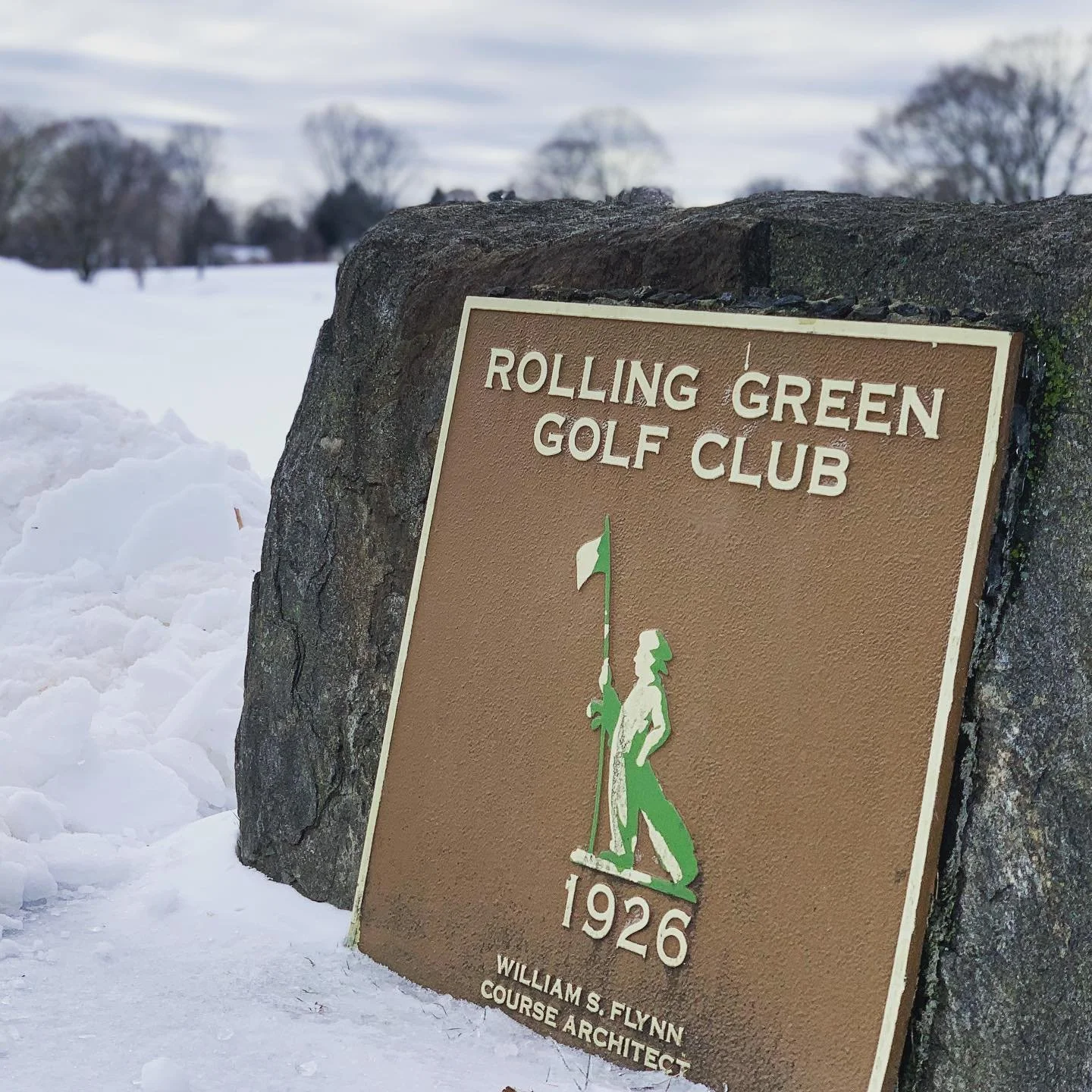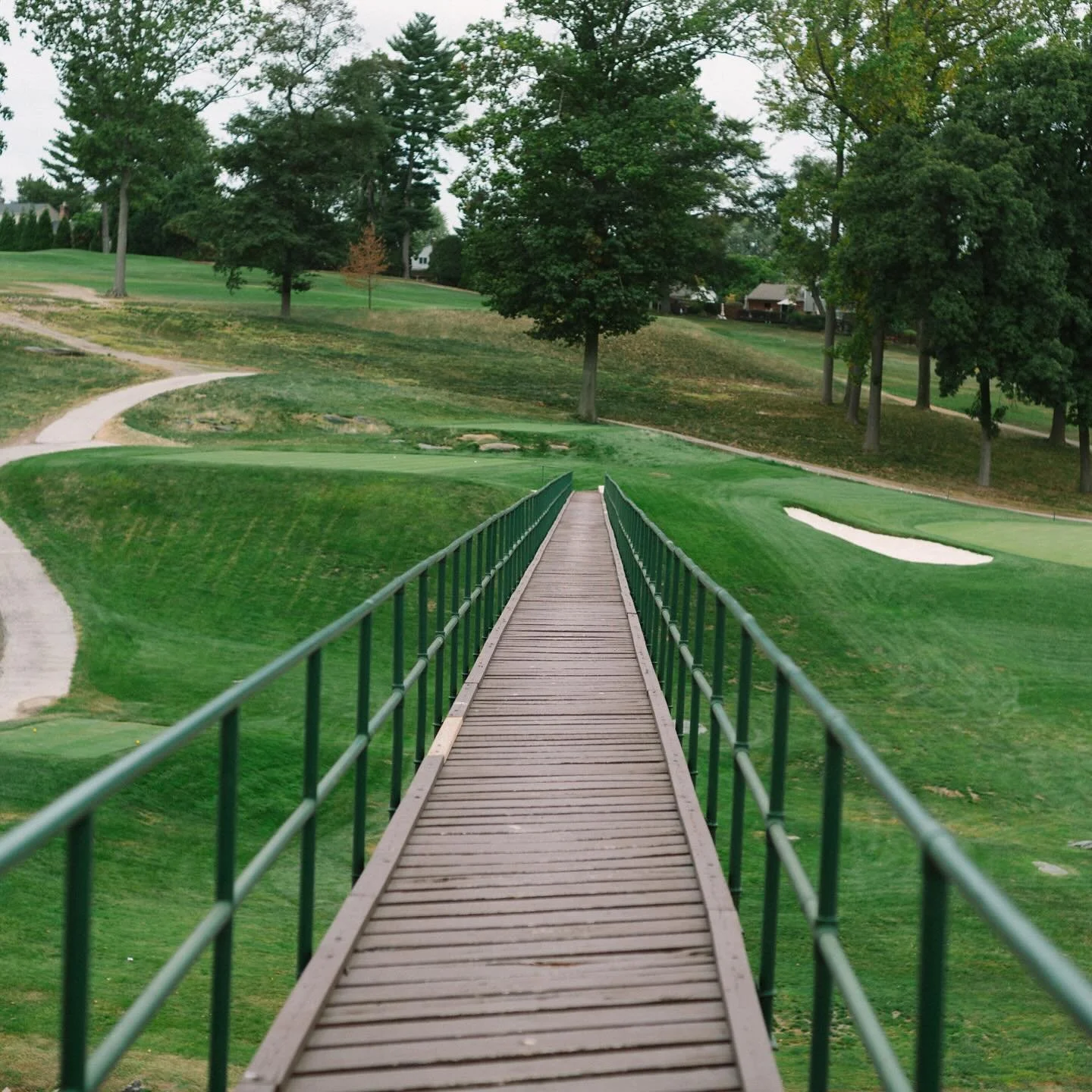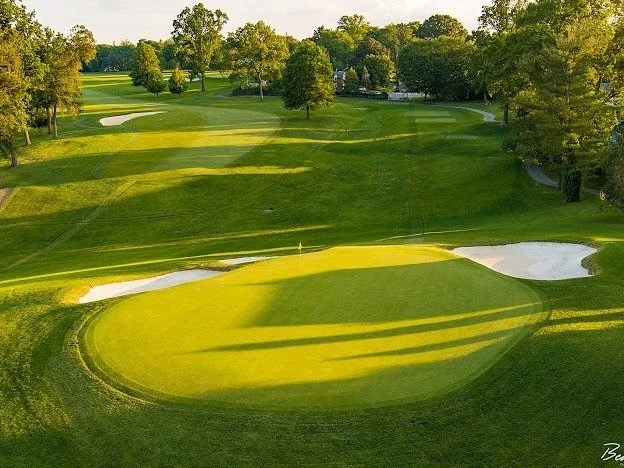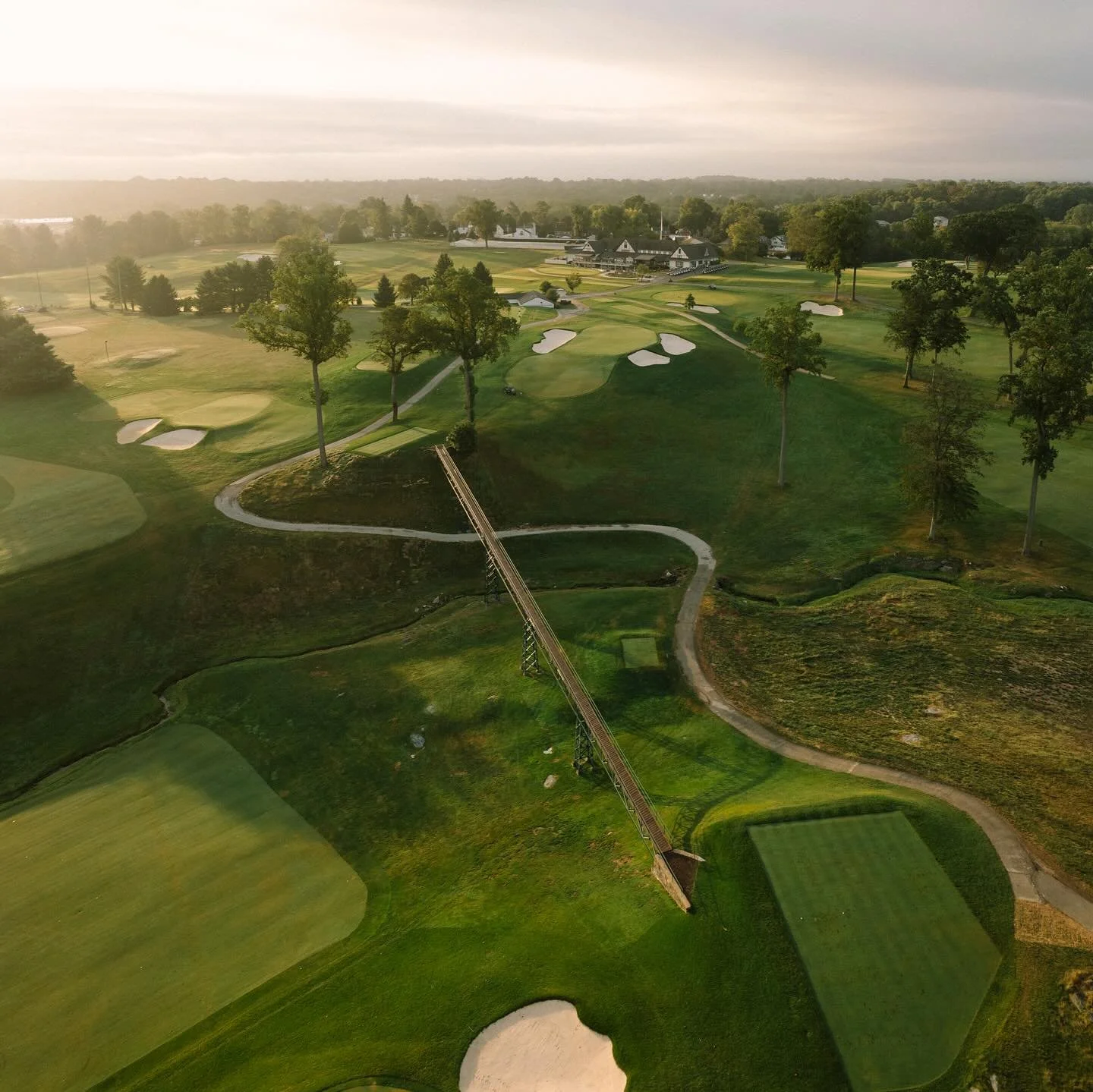ROLLING GREEN GOLF CLUB
Course Architect(s): William S. Flynn/Howard C. Toomey (1925),
Ron Forse Design, Inc. (Restoration - 2008-09).
Year Opened: July 31, 1926
Location: Springfield, Pennsylvania
Slope: 136. Rating: 73.5
Par: 70
Yardage: 6,917
Hole-by-Hole: 1 - Par 4 420 Yds 10 - Par 3 258 Yds
2 - Par 4 449 Yds 11 - Par 4 451 Yds
3 - Par 3 175 Yds 12 - Par 4 362 Yds
4 - Par 4 392 Yds 13 - Par 4 445 Yds
5 - Par 4 430 Yds 14 - Par 3 235 Yds
6 - Par 3 205 Yds 15 - Par 4 379 Yds
7 - Par 5 503 Yds 16 - Par 3 164 Yds
8 - Par 4 442 Yds 17 - Par 5 501 Yds
9 - Par 5 615 Yds 18 - Par 4 491 Yds
Par 36 3,631 Yds Par 34 3,286 Yds
Key Events Held: U.S. Women's Open (1976),
Francis X. Hussey Memorial (1985-present),
U.S. Women's Amateur Championship (2016).
Awards Won: #92 by GolfWeek - Best Classic Courses before 1960 (2009-10),
#18 by Golf Digest - Best in State, Pennsylvania (2007-08),
#8 by Golf Digest - Best in State, Pennsylvania (2000-01).
Web site: www.rggc.org.
HISTORY: The origin of Rolling Green Golf Club dates back to 1920, when several golfers from nearby country clubs wanted to form a new club, strictly for golf. No swimming pools and tennis courts, just golf.
Spearheaded by Joseph E. Haines, it took nearly four years to form a membership and purchase enough tracts of land, 157 acres in all, to begin the process of building a new club.
The choices to craft a new layout in the golf-rich Philadelphia region were William Flynn and Howard Toomey.
Flynn was primarily responsible for the design, and Toomey the construction of most of the courses - including Rolling Green - the duo created.
Flynn also assisted Hugh Wilson in the completion of the East Course at Merion Golf Club, while some of the gems that Toomey and Flynn collaborated on or redesigned read like a who's who of golf courses, such as; Huntingdon Valley, Shinnecock Hills, Atlantic City Country Club and the Cascades Course at The Homestead.
By the end of the summer of 1926, Rolling Green opened with a full membership of 335. A local newspaper recounted the historic event: "The original purpose of the club's founders was to omit all social frills that enter into the life of a country club, and make it a shrine where the skill and ingenuity of the lover of the game could have full play."
Joe Ryan was named the club's first greenskeeper, a position he held for over 30 years. Ryan, who retired in 1957, lived in a stone house dating back to the mid-1700s, regarded as the fourth-oldest dwelling in the county.
Much of Rolling Green's vegetation and beauty comes from the hand of Ryan, who was a superb greenskeeper and was elected as president of the Golf Course Superintendents Association of America in 1938.
Fifty years after first opening its doors, Rolling Green was named host of the 1976 U.S. Women's Open Championship. JoAnne Carner defeated Sandra Palmer in a playoff for her second Women's Open Championship.
Carner, who captured the 1971 U.S. Women's Open, also in Pennsylvania, claimed the lead at the halfway point after her second consecutive round of 71. She led Palmer by two shots, but the advantage was short-lived, as Palmer shot 73 to Carner's 77 in the third round. Jane Blalock, who finished third, stood only three shots behind with one round to play, but a final score of 76 would
place her four shots off the pace.
Trailing Palmer by two heading into the final round, Carner took the lead after parring the first 10 holes, while Palmer struggled with four bogeys on the first five holes. Palmer drew even on the 15th and both players finished with a birdie on 17 and a par on 18 to force a playoff. Carner shot 73
compared to Palmer's 75, as the duo finished regulation at eight-over-par.
During the playoff, Carner opened up an early advantage, however Palmer took the lead after 12 holes. With a birdie on 17 and a par on 18, Carner would rebound to defeat Palmer by two shots, as the pair shot rounds of 76 and 78.
Nancy Porter made only the fifth hole-in-one in Championship history, as she aced the 16th hole during round two. It should be noted that Porter is the only player in U.S. Women's Open history to record two holes-in-one. She also made an ace during the 1972 championship at Winged Foot.
The course proved to be the real winner though. Despite playing just 6,066 yards, the cut came at 15-over-par and only three players broke par all week. Connie Chillemi fired a two-under 69 in round one and Palmer and Susie McAllister shot rounds of 70, in the first and third rounds respectively.
Wishing to put the course back on the map, so to speak, the membership sought the services of the restoration firm of Forse Design. Spearheaded by Ron Forse and Jim Nagle, this pair has restored some of the finest layouts in the northeast region, such as Philadelphia CC, Bedford Springs Resort, Salem CC, Saucon Valley CC and Newport CC.
"It's a great golf course for all the different aspects," Nagle said. "Difficulty, challenge, strategy, putting, driving, approach shots to the green. It encompasses the whole game. That's the great thing about Rolling Green and many of William Flynn's creations."
The membership was totally committed to the restoration and nearly $1 million later, the course re-opened with new teeing grounds, restored bunkers and reshaped holes, without interrupting the integrity of the Flynn design.
The restoration worked, as Rolling Green was awarded the 2016 U.S. Women's Amateur Championship.
"The USGA is very happy to bring another national championship to Rolling Green," said Thomas J. O'Toole Jr., USGA vice president and Championship Committee chairman. "The course has already proven to be a formidable test, and it will undoubtedly present yet another stern challenge when it hosts the world's finest female amateur players."
Korean Eun Jeong Seong defeated Virginia Elena Carta from Italy in dramatic fashion, as she sank a 40-foot birdie putt on the 36th hole for the win and the U.S. Women’s Amateur title.
HOLE-BY-HOLE ANALYSIS: The opening hole at Rolling Green is a straightforward par four of 420 yards, one of seven that surpass the 400-yard mark. Playing slightly downhill, trees occupy both sides of the fairway with sand to the right of the landing area. With the fairway canting off to the right, an error to this side will result in tree jail. A medium to short iron will remain to a fairly large putting surface, that slopes wickedly from back to front. A pair of deep green-side bunkers guard the promise land to the left, making for a difficult up and down. Play towards the center of the green and rely on your flat stick.
Number two is a wonderful, dogleg left par four, the second longest on the course. From an elevated tee, you'll need to draw the ball around a trio of traps that guard the corner. Play to far out to the right and you'll end up in deep rough. A possible long iron might remain to a well-guarded, sloped green. A back-left pin will bring one of the two traps into play. The putting surface runs from left to right and back to front, so any play short, will spin back off the green. A classic par four.
The first par three on the course is one of the most deceiving at Rolling Green. Playing downhill at 175 yards, the key of the third is knowing the putting surface. Two deep traps guard the left and one right, but it's the green that presents the difficulty, as looks are deceiving. When standing on the green, it feels that it rolls from back to front, but the members will tell you that the putting surface runs towards the rear. Trust me, it does.
At 392 yards, most would feel that the fourth hole gives the player somewhat of a break in his round, but don't be fooled. Tall trees down the right side, force a fade off the tee, however, with OB, tall oaks and a stream left, doubt certainly creeps into your mind. Not to mention one of the tightest fairways on the course, so good luck. Although a successful tee ball will leave a short iron, your second shot is played directly uphill, so you'll need to add a club or two. By the way, the green is the fastest on the course, running hard from back to front. If you miss the putting surface, you might be better off in the bunker than chipping to get it close. Watch out for a back-left pin. That's a wicked green.
The fifth is another 400-plus par four, that plays uphill towards the landing area and slightly downhill to the green. Little trouble off the tee, as long as you clear the right, fairway bunker. A medium iron, with a slight fade, should suffice in an attempt to attack the pin. Two fronting bunkers are not to be messed with. The green has subtle undulations, but it can be had.
Although rated as the 15th easiest hole on the course, the sixth is anything but easy. Reaching 205 yards from the black markers, this par three requires a long iron to an elevated green the slopes from back to front. Three deep traps, that sit well below the putting surface, guard the long, narrow green.
To say that pinpoint accuracy is required, would be an understatement.
The first par five on the course, the seventh is a definite round maker. At just 503 yards and playing downhill, you'll have an iron to the green, as long as you hit the fairway. With trees guarding both sides of the landing area and a creek left and in the center of the fairway, I suggest three-metal off the
tee. Your second shot is slightly uphill to a very accessible green. Play towards the right side, as the slope of the hole bends towards the putting surface. The green is long and rolls from front to back, so land short of the green and let the course do the work. A definite birdie chance.
The closing two holes on the front nine are as good as it gets in the Philadelphia region.
Number eight is a robust 442-yard par four that requires length, accuracy and a little bit of luck. Your tee shot must be precise, as a creek wraps around the right side of the fairway and cuts across the landing area at the 250-yard mark. Play short of the creek on the left side, and you're left with a longer approach. You'll need to add two clubs to your second shot, as the green sits well above the fairway. Any shot short of the putting surface, will roll down the fairway, 50-75 yards away. To make matters worse, the green slopes hard from back to front and when the pins up, well, good luck.
The last hole on the outward nine is also the longest on the course at a whopping 615 yards. Not only that, it's uphill all the way home. You'll need to crack a drive and favor the left side, as the fairway cants to the right, shoving most shots out of the fairway. I'd find it hard to believe that anyone could get home in two, but you'll still need a three-metal with your second. Right side with your layup is best, avoiding the sand on the left.The climb continues with your short iron to a fairly benign putting surface, but, beware of the sand right and left, especially with a back-left pin. This is the number one handicapped hole on the course with good reason.
The difficulty continues with the par-three 10th. Mainly because it plays like a par four at 258 yards. Slightly uphill, if you could sling a draw from right to left, you'll gain a little bit of an advantage, as the slope of the fairway kicks towards the green. Sand left is deep and difficult, while the trap on the right is no bargain either. A par here can go along way on the card.
Despite it's 451-yard length, the par-four 11th is not as difficult at first blush. Playing downhill from the tee, the fairway is protected by just one bunker down the left side with plenty of bailout space to the left, albeit rough. Your approach shot will be played back uphill to the green which angles to the right. Sand left and a deep-faced bunker to the right provide plenty of support to the course to protect par. Miss long and right and you'll find yourself down a deep embankment. The putting surface is slick and falls from left to right, so play accordingly.
One of the many signature holes at Rolling Green is the visually stunning, yet simple 12th. At 362 yards, it's the shortest par four. From an elevated tee box, everything is right in front of you. A dogleg to the right, with a pair of traps down the right and one left, you'll need to decide on driver or the more sensible play, a fairway metal, since the landing area is generous. Just a short iron will remain to an uphill putting surface. The green is long and narrow with several bunkers guarding the entrance. A word of caution, avoid the trap that lurks, short and right, it's a doozy.
The bank nine continues to heat up at the 13th, with the second hardest hole on the course. A really difficult par four, it starts off with a semi-blind tee shot to a fairway that tilts to the right. Your second shot is the real kicker, as it must clear a valley of almost 200 yards to reach the raised green. The putting surface breaks hard from left to right and any shot short or right will make for an almost impossible up and down. Truly one of the gems at Rolling Green.
If you thought the 10th was demanding, the par three 14th is rated as the sixth most difficult on the course. At 235 yards from the tips, this par three is all carry over a ravine and uphill to the green. A deep embankment lurks to the right, along with a deep trap. Another bunker on the left will keep you honest. The putting surface is long and slopes from left to right. Not easy to make par when you're teeing off with metal instead of iron.
The dogleg left, par-four 15th concludes a rugged three-hole stretch that includes three of the sixth-hardest holes on the course. The difficulty here is two-fold. First the tee shot. From a chute of trees, the tall timber flanks both sides of the fairway, as it plays downhill towards the landing area. Now
its uphill to the two-tiered putting surface. Make sure you take enough club, otherwise, your approach will come back to your feet. The green is long and guarded by a half-a-dozen traps.
The fifth and final par three on the course is also the shortest at 164 yards. A gem in the shadow of tall trees, this slightly uphill one-shotter features three framing traps in the rear and a pair fronting the green. The putting surface is quite long and rolls from left to right. A word of caution, do not
miss right, as your approach will fall off hard towards a creek, that lays not so innocently below the surface.
Number 17 is certainly a birdie hole, reaching just 501 yards from the tips and playing as a par five. The key to success is the tee shot, which must find the fairway on this dogleg left. A wrap-around tee ball must avoid the tall trees and sand down the left, thus setting up a real good chance of getting
home in two. Take advantage of the opening in front of the green for your best shot at three. The putting surface is slightly raised so plan accordingly if you laid up. The green rises from front to back, so be below the hole to gain a shot.
The closing hole can play as a par five at 529 yards, but as a four from the back tees, well, you'll need to be quite precise just to make par. Downhill from the tee, trees guard the entire right side through the green, not to mention a trio of traps at the corner of the right dogleg. Here's where you'll need your best, as it's now straight uphill to the green, with trees encroaching on the fairway from both sides. The putting surface slopes from back to front, with little undulation.
FINAL WORD: Golf in the Delaware Valley always starts with Pine Valley and Merion and with good reason, as both are justifiably ranked in the top-10 in the United States. Aronimink, Huntingdon Valley and Philly Country Club are next in line on many lists, but, Rolling Green Golf Club must not and should not be overlooked.
A perennial favorite for years, Rolling Green had drifted from the limelight, as new courses began to open and other venues received facelifts.
Enter the firm of Forse Design and their restoration of a time-honored classic.
Regionally located in western Pennsylvania, Ron Forse and his partner Jim Nagle have revived the layout and brought it into the 21st century and beyond.
Through successful research of historical photos, Forse and company were able to restore the bunkers throughout the course to their original specifications and reshape several holes without deviating from the Flynn design. The bottom line...money well spent.
The rolling fairways have a mind of their own and the greens, well, if putting is not your forte, good luck. The putting surfaces, which were virtually untouched, are true, slick, undulating and sometimes nasty...in a good way.
With the addition of several new tee boxes, Rolling Green now stretches to 6,917 yards and can play to a par of 70. A perfect fit, if you ask me, for a possible USGA event in the future, something club president Peter Voudouris has been pushing. "The USGA has come out to visit us," said Voudouris. With the success of the recent Walker Cup at Merion in 2009, who knows?
Challenge, beauty and history, Rolling Green is as a diverse and venerable a layout as the previously-mentioned gems, and has been brought back to the forefront of American golf architecture.



















